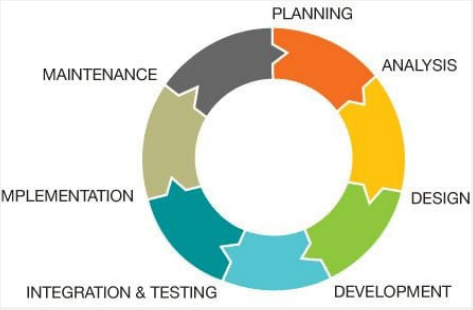7 STAGES OF SOFTWARE DEVELOPMENT CYCLE
Today, technology has become an integral part of our lives. Day in and day out we use thousands of softwares or applications for various purposes like gaming, editing, streaming, social media, etc. but have you ever wondered how these softwares are developed and maintained? In this article we will try to explain the different models of software development lifecycle and process.
${tocify}
Behind every software that exists on your device, there is a framework known as Software Development Life Cycle or SDLC. Agile Software development lifecycle methodologies suggest that tt is a structured process that enables the production of high-quality, low-cost software, in the shortest possible production time. The goal of the SDLC is to produce superior software that meets and exceeds all customer expectations and demands. The SDLC defines and outlines a detailed plan with stages, or phases, that each encompasses its own process and deliverables. Though SDLC has various models of execution, certain core phases are common to all of them:
1. Planning phase
- The planning phase encompasses all aspects of project and product management. This typically includes resource allocation, capacity planning, project scheduling, cost estimation, and provisioning. During this phase, the team determines not only what is desired in the software, but also
what is not wanted.
2. Analysis and defining requirements
- This phase focuses precisely on feasibility analysis and the requirements that the application should meet. At this stage, the developers often create a software requirements specification (SRS) document. An SRS document is a description of the software’s aim and expected performance. It also includes the functionalities that the application should offer.
3. Design
- SRS details act as the single point of reference for Software architects to chart out the best design for product development. Usually, it is a practice to come out with multiple solutions and prepare a Design Document Specification (DDS) with a detailed solution approach. The final design solution mentions what all modules should it have, their architecture, workflows, entity, and data-flow diagrams along with the third-party dependencies if any.
4. Build Phase
- This phase has many names such as the Development or Coding or Implementation phase. At this stage, the actual development starts based on the agreed blueprint laid down by the DDS. A well-written design document that has sufficient, structured, and apt details, can make coding relatively easy and assist the developer to finish on time. Every organization has coding standards, guidelines, and best practices that intend to produce quality and reusable code. All the programmers are mindful of them while working on a development task.
5. Testing
– The testing phase of the SDLC is one of the most important. It is difficult to convey quality programming without testing. There is a wide assortment of testing important to gauge quality. Testing can be done manually or automatically.
6. Deployment
– This phase is also known as the Acceptance phase or the Beta Evaluation phase. After the Software testing finishes successfully, the product gets ready to ship to the customer for deployment. In some organizations, they split this phase into sub-phases as per their business policies. They first do a release specifically for a market-facing group of people and the software gets tested in a real-time environment for their acceptance. It is a sort of User Acceptance Testing (UAT).
7. Maintenance
- After the software clears all the SDLC phases without any issues, then it goes into the maintenance stage. It allows the customers to request upgrades and get the fixes/patches for problems internally or externally identified. Most of the software companies adhere to all the seven steps to deliver the product with the maximum possible quality.

